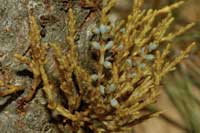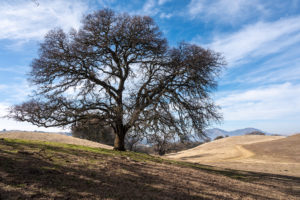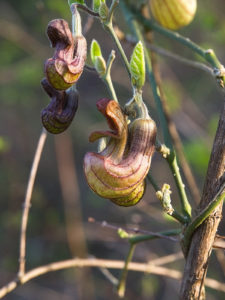Most people know just one thing about mistletoe: Watch out for it at Christmas parties or you might find yourself in a compromising position. But there’s a lot more to this plant than that one-note holiday refrain. In fact, the tradition of kissing under a mistletoe seems downright odd when you consider that this plant is by nature a parasite.
Mistletoes are found all over the world, from the boreal forests of Alaska to the tropical forests of Australia, with five diverse families and many hundreds of species united by one basic survival strategy. In California, mistletoes fall into two groups: leafy mistletoes (Phoradendron) and dwarf mistletoes (Arceuthobium). Both are parasites that derive water, nitrogen, and carbon from the branches of their host trees.
People are generally more familiar with leafy mistletoes because these are common on oaks and are sold in stores during the Christmas season. Dwarf mistletoes are considerably more subtle; only a few inches tall, they lurk among the evergreen needles of conifers. California is home to seven species of leafy mistletoe and 12 species of dwarf mistletoe; each species infects either a single species of host tree or a group of related host trees.
Close up, the parasitic mistletoe is such a strange-looking life-form that it’s hard to imagine how it survives. Its succulent stems and foliage, sickly yellow or greenish-orange, sprout like sinister bonsais from tree branches and have a toughness somewhere between that of wood and leaf. Technically, mistletoes are hemiparasites because their evergreen leaves can photosynthesize to varying degrees, but they still meet all of their water and mineral needs by sinking roots into the xylem of their host trees.
In the fall, mistletoes get down to the business of procreation. Leafy mistletoes produce copious crops of nutritious fruits that are consumed by a wide range of fruit-eating birds, including robins, bluebirds, waxwings, and phainopeplas. The sticky seeds are later defecated onto the sun-warmed surfaces of branches, where birds prefer to perch; here they adhere to the bark and germinate over the ensuing winter.
- Dwarf mistletoe photo by Dave Hildebrand.
Dwarf mistletoes have an explosive seed dispersal system whereby fruits plump up with water as they mature. At some point the fruits burst with such force that the sticky seeds get propelled to surfaces up to 40 feet away. A gooey coating on the seeds absorbs water over the rainy season, then loosens up and allows the seed to slide down the surface of the branch until it lodges at the base of conifer needles, or drops onto a lower branch where it tries again.
The microscopic opening in a tree’s bark at the base of each conifer needle provides the perfect location for a dwarf mistletoe seed to insert delicate “sinker” roots (called haustoria) that penetrate the tree’s life-giving circulatory system. The “sinkers” of all mistletoes spread and grow within the host branch for a period of two to 12 years before sending up aerial shoots and leaves of their own. This gives the mistletoe a solid “toehold” on its new host and ensures that the aerial parts of the plant will receive a steady supply of nutrients.
In large numbers mistletoes may compromise a tree’s health and weaken its defense against harmful fungi, but they are not outright tree-killers. After all, mistletoes and trees have flourished and evolved together for nearly 20 million years. Mistletoes actually play a significant ecological role in forest habitats and have a positive effect on biodiversity by opening up the forest canopy and providing dependable food and homes for many animal species.
Throughout recorded history, cultures around the world have drawn metaphors from the mistletoe’s strange life habits. Both Native Californian and ancient European cultures believed that the life force of deciduous oaks withdrew into the still-living mistletoe during the winter months when oaks dropped their leaves and appeared dead. The plant was part of early Christian traditions and it continued to be celebrated in Europe into the early 20th century. Our tradition of kissing under a mistletoe sprig on winter holidays may simply have originated from a belief that the spirit of mistletoe presaged the coming fertility of spring.

.jpg)




